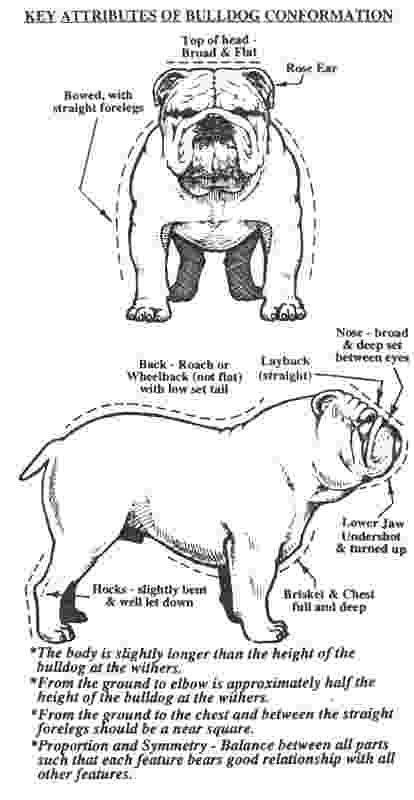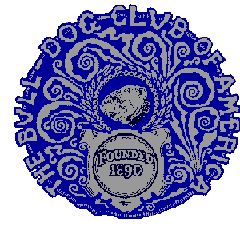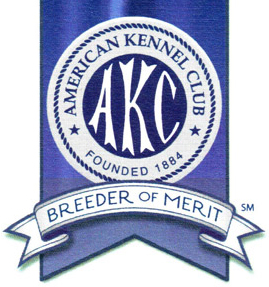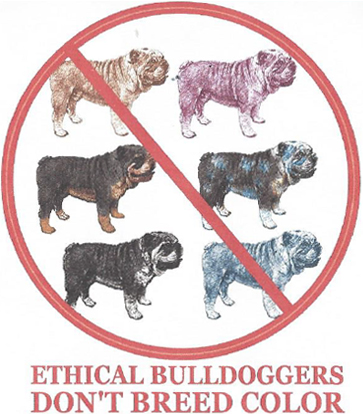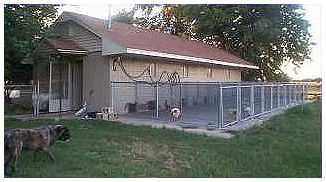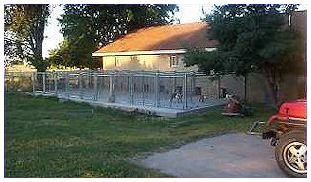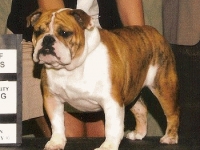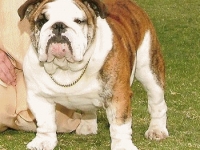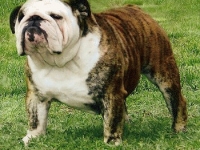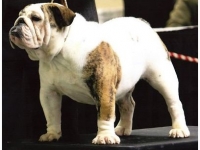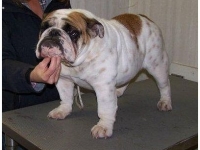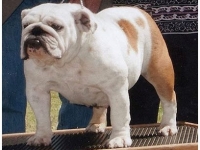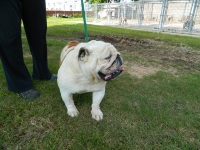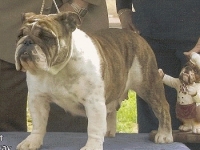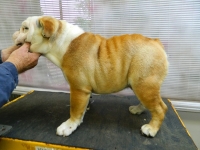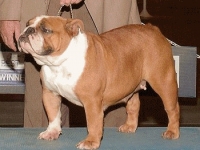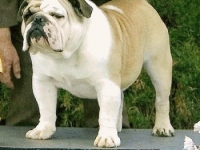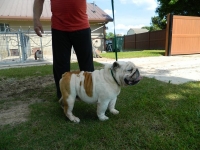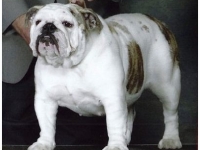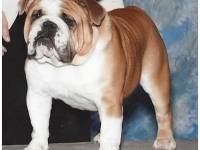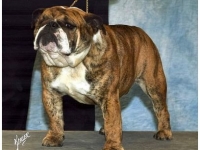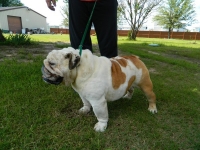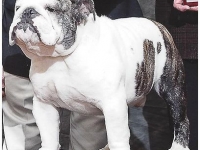An Illustrated Guide to the Official Standard of the Bulldog
This document is adapted from the “The Bulldog — An Illustrated Guide to the Standard” which was prepared by the Education Committee of the BCA, copyright 1995. In what follows, the wording of the official standard is set in regular type. The clarifications are set in italic type.
Bulldog History
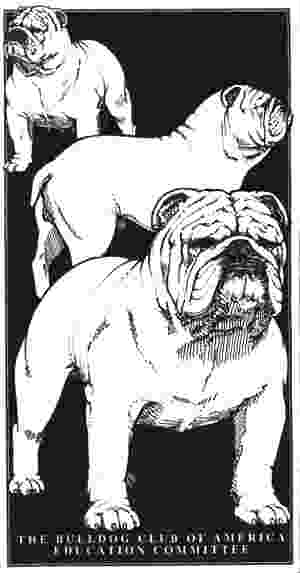
Authorities differ completely about the origin of the Bulldog. They even have differing spelling of the name. Be it Bondogge, Boldogge, Bandogge, the final spelling is BULLDOG.
There are even those who dispute why he is called Bulldog. Is it the shape of the head or because of his use in the barbaric sports of bull-baiting, bear-baiting and dog fighting?
Whatever the name or the origin, there is little doubt that centuries ago there was a canine resembling our present day Bulldog. Lighter boned and higher on leg, but with the courage, tenacity and determination that still exists today. Over the years, other breeders have crossed with the Bulldog to give these traits to their breeds, perhaps the best known being the Greyhound
After bull-baiting, bear-baiting and dog fighting were prohibited in 1835, a few dedicated fanciers worked diligently to breed out the aggressive, vicious tendencies and to modify the Bulldog to look more like we see him today, shorter faced and heavier in structure.
The first Bulldog Standard in England was drafted in 1864 and adopted in 1875. The Bulldog Club of America was formed in 1890 utilizing the English standard. In 1896 a standard was adopted by the Bulldog Club of America. It was revised in 1914 to declare the Dudley nose a disqualification. In 1976 the Dudley nose disqualification was redefined as a “brown or liver colored nose.” The standard was reformatted in 1990 with no changes in wording.
Official Breed Standard
General Appearance
The perfect Bulldog must be of medium size and smooth coat; with heavy, thickset, low-swung body, massive short-faced head, wide shoulders and sturdy limbs. The general appearance and attitude should suggest great stability, vigor and strength.
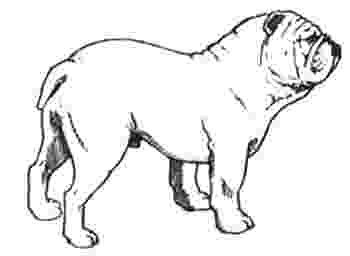
Sound sturdy limbs and the suggestion of great stability, vigor and strength are as important to the present day’s Bulldog as they were to its ancestors.
The disposition should be equitable and kind, resolute and courageous (not vicious or aggressive), and demeanor should be pacific and dignified. These attributes should be countenanced by the expression and behavior.
Size, Proportion, Symmetry
Size — The size for mature dogs is about 50 pounds; for mature bitches about 40 pounds.
Proportion — The circumference of the skull in front of the ears should measure at least the height of the dog at the shoulders.
Symmetry — The “points” should be well distributed and bear good relation one to the other, no feature being in such prominence from either excess or lack of quality that the animal appears deformed or ill-proportioned.
Influence of Sex — In comparison of specimens of different sex, due allowance should be made in favor of the bitches, which do not bear the characteristics of the breed to the same degree of perfection and grandeur as do the dogs.
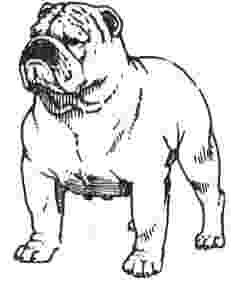
The bitch should have equal qualities, but an allowance shall be made for the femininity that is characteristic of the bitch.
Head
Eyes and eyelids — The eyes, seen from the front, should be situated low down in the skull, as far from the ears as possible, and their corners should be in a straight line at right angles with the stop. They should be quite in front of the head, as wide apart as possible, provided their outer corners are within the outline of the cheeks when viewed from the front. They should be quite round in form, of moderate size, neither sunken nor bulging and in color should be very dark. The lids should cover the white of the eyeball, when the dog is looking directly forward, and the lid should show no “haw”.
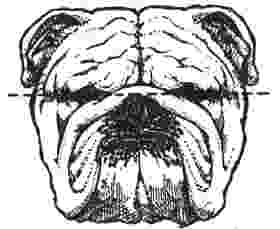
An imaginary horizontal line passing through the four corners of the eyes should be at a right angle with the stop and just rest on top of the nose. Though the shape of the eye is round, the eyelids give a more almond look to the eye.
Ears — The ears should be set high in the head, the front inner edge of each ear joining the outline of the skull at the top back corner of skull, so as to place them as wide apart, and as high, and as far from the eyes as possible. In size they should be small and thin. The shape termed “rose ear” is the most desirable. The rose ear folds inward at its back lower edge, the upper front edge curving over, outward and backward, showing part of the inside of the burr. (The ears should not be carried erect or prick-eared or buttoned and should never be cropped).
Rose Ears

When viewed from the front and side, top of ears should be level with top outline of the skull with the burr partially exposed and the entire edge of the ear visible.
Proper Ears
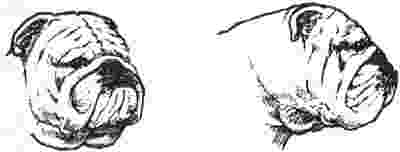
Faulty Ears

Skull — The skull should be very large, and in circumference, in front of the ears, should measure at least the height of the dog at the shoulders. Viewed from the front, it should appear very high from the corner of the lower jaw to the apex of the skull, and also very broad and square.
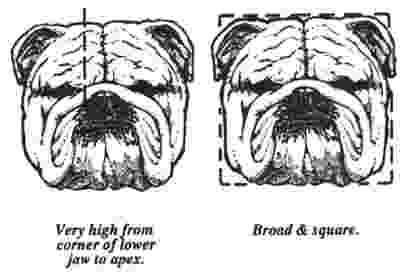
Viewed at the side, the head should appear very high, and very short from the point of the nose to occiput. The forehead should be flat (not rounded or domed), neither too prominent nor overhanging the face.
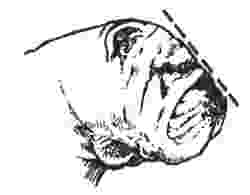
Head very high showing good layback. An imaginary line should touch the lower jaw, tip of nose and top of head. LONG, FLAT forehead.
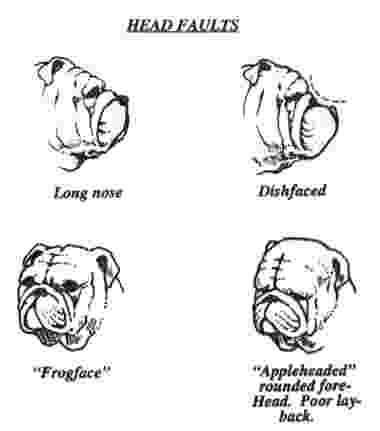
Cheeks — The cheeks should be well-rounded, protruding sideways and outward beyond the eyes.
Stop — The temples or frontal bones should be very well defined, broad, square and high, causing a hollow or grove between the eyes. This indentation, or stop, should be both broad and deep and extend up the middle of the forehead, dividing the head vertically, being traceable to the top of the skull.
Indentation in skull, called “the furrow” extends from between the eyes to top of head. Not to be obscured by forehead wrinkles.
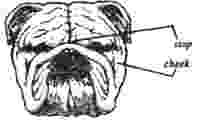
Proper Head
Face & Muzzle — The face, measured from the front of the cheekbone to the tip of the nose, should be extremely short, the muzzle being very short, broad, turned upward and very deep from the corner of the eye to the corner of the mouth.
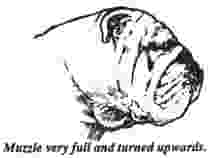
Nose — The nose should be large, broad and black, its tip set back deeply between the eyes. The distance from bottom of stop, between the eyes, to the tip of the nose should be as short as possible and not exceed the length from the tip of nose to the edge of underlip. The nostrils should be wide, large and black, with a well-defined line between them. Any nose other than black is objectionable and a brown or liver-colored nose shall disqualify.
Front of nose slants back closely following contour of head. Not perpendicular. Large, black, wide nostrils. In the scale of points, the nose has 6, more than any other feature.
Lips — The chops or “flews” should be thick, broad, pendant and very deep, completely overhanging the lower jaw at each side. They join the underlip in front and almost or quite cover the teeth, which should be scarcely noticeable when the mouth is closed.
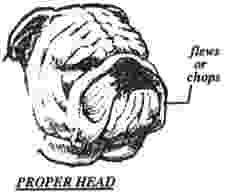
Bite/Jaws — The jaws should be massive, very broad, square and “undershot”, the lower jaw projecting considerably in front of the upper jaw and turning up.
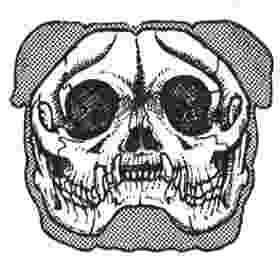
Skull formation showing correct swing of jaw.
A wry or crooked jaw is a serious fault.
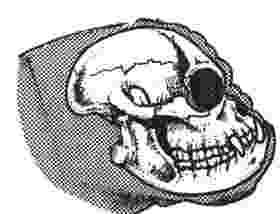
The correct jaw, so eagerly sought after in the fancy, with the upward thrust, retaining the curve throughout.
Faulty Jaws
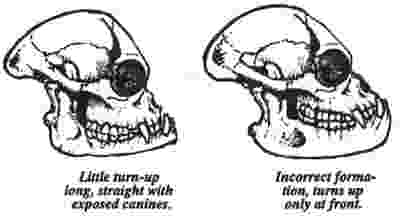
Teeth — The teeth should be large and strong, with the canine teeth or tusks wide apart, and the six small teeth in front, between the canines, in an even, level row.

Neck, Topline, Body
Neck — The neck should be short, very thick, deep and strong and well arched at the back.
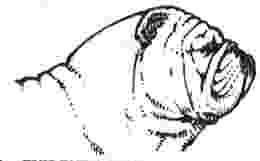
Neck short but EVIDENT and WELL-ARCHED. Too short a neck gives an overall unbalanced appearance.
Topline — There should be a slight fall in the back, close behind the shoulders (its lowest part), whence the spine should rise to the loins (the top of which should be higher than the top of the shoulders), thence curving again more suddenly to the tail, forming an arch (a very distinctive feature of the breed), termed “roach back” or, more correctly, “wheel back”.
Proper Topline
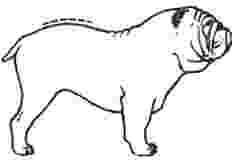

Body — The brisket and body should be very capacious, with full sides, well rounded ribs and very deep from the shoulders down to its lowest part, where it joins the chest. It should be well let down between the shoulders and forelegs, giving the dog a broad, low, short legged appearance.
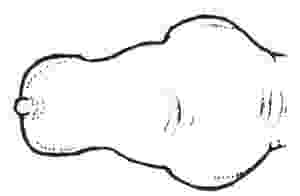
Wide shoulders, barrel ribs and a narrow pelvic area give the Bulldog a “pear-shaped” body.
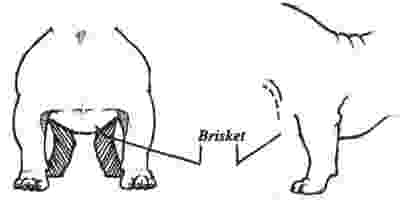
Brisket well let down between the forelegs. Fullness of the brisket can be observed in front of the forelegs from side view.
Chest — The chest should be very broad, deep and full.
Underline — The body should be well-ribbed-up behind with the belly tucked up and not rotund.
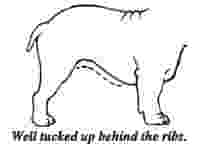
Back & Loin — The back should be short and strong, very broad at the shoulders and comparatively narrow at the loins.
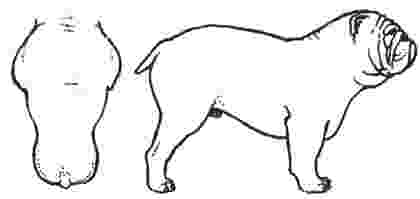
A back of correct length creates a balanced appearance and facilitates correct Bulldog movement.
Bulldogs appear to be slightly longer in body than their height at the shoulder.
Tail — The tail may be either straight or “screwed” (but never curved or curly), and in any case must be short, hung low, with decided downward carriage, thick root and fine tip. If straight, the tail should be cylindrical and of uniform taper. If “screwed”, the bends or kinks should be well-defined, and they may be abrupt and even knotty, but no portion of the member should be elevated above the base or root.
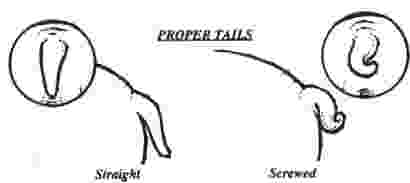
Two types of tail are desired in the Standard. Each are short, hung low, heading down with thick root and fine tips.
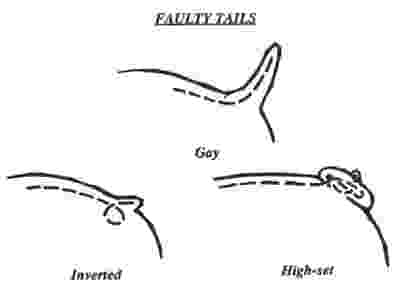
Forequarters
Shoulders — Should be muscular, very heavy, widespread and slanting outward, giving stability and great power.
Forelegs — The forelegs should be short, very stout, straight and muscular, set wide apart, with well-developed calves, presenting a bowed outline, but the bones of the legs should not be curved or bandy, nor the feet brought too close together.
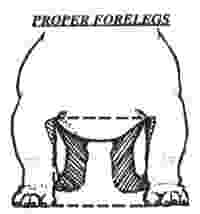
Correct turn of shoulder with proper front legs showing straight perpendicular inner forelegs will form a near square from the top of the legs and across.
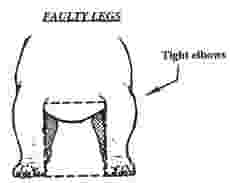
Narrow-fronted showing a vertical rectangle between the front legs. Undesirable.
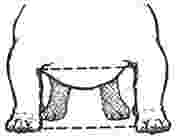
An obvious rectangle between the front legs, indicating legs that are too short, of shoulders that are too wide or both. Undesirable.
Elbows — The elbows should be low and stand well out and loose from the body.
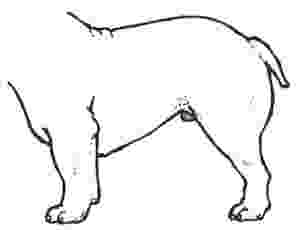
Well constructed Bulldogs from ground to elbow should be about 50% of the distance from ground to height at the withers.
Faulty Elbows — “Loose from the body” does NOT mean overly loose elbows. It means that they should not be directed towards the ribs (tight elbows). Neither should they be directed outward away from the ribs (overly loose elbows). Overly loose elbows is a VERY serious structural fault.
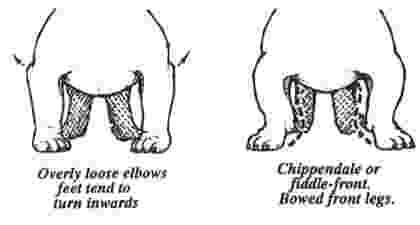
Feet — The feet should be moderate in size, compact and firmly set. Toes compact, well-split-up, with high knuckles and very short stubby nails. The front feet may be straight or slightly out-turned.
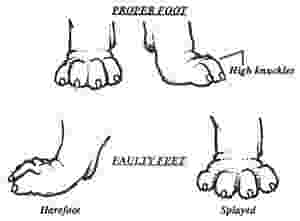
Hindquarters
Legs — Hind legs should be strong and muscular and longer than forelegs, so as to elevate loins above shoulders. Hocks should be slightly bent and well-let-down, so as to give length and strength from loins to hock. Lower leg should be short, straight and strong, with stifles turned slightly outward and away from the body. Hocks are thereby made to approach each other, and the hind feet to turn outward.
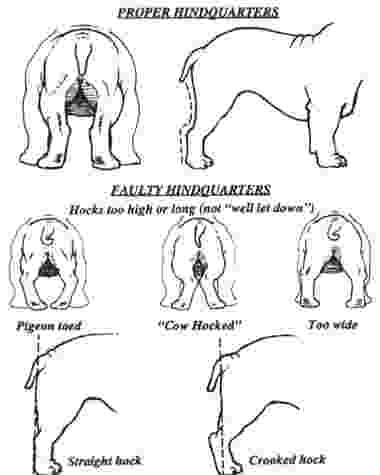 Feet — Should be moderate in size, compact and firmly set. Toes compact, well-split-up, with high nuckles and short stubby nails. Hind feet should be pointed well-outward.
Feet — Should be moderate in size, compact and firmly set. Toes compact, well-split-up, with high nuckles and short stubby nails. Hind feet should be pointed well-outward.
Coat & Skin
Coat — Should be straight, short, flat, close, of fine texture, smooth and glossy. (No fringe, feather or curl).
Skin — The skin should be soft and loose, especially at the head, neck and shoulders.
Wrinkles and dewlap — The head and face should be covered with heavy wrinkles, and at the throat, from jaw to chest, there should be two loose pendulous folds, forming the dewlap.
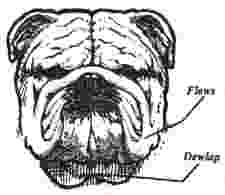
Forehead wrinkle should not obscure furrow in skull. Wrinkle(s) over the nose to be of moderate size, neither extending beyond the tip of the nose, obscuring vision in any way nor being too large and out of proportion.
Color of Coat
The color of coat should be uniform, pure of its kind and brilliant. The various colors found in the breed are to be preferred in the following order: 1. red brindle; 2. all other brindles; 3. solid white; 4. solid red, fawn or fallow; 5. piebald; 6. inferior qualities of all the foregoing. Note: A perfect piebald is preferable to a muddy brindle or defective solid color. Solid black is very undesirable, but not so objectionable if occuring to a moderate degree in piebald patches. The brindles to be perfect should have a fine, even and equal distribution of the composite colors. In brindles and solid colors a small white patch on the chest is not considered detrimental. In piebalds the color patches should be well-defined, of pure color and symmetrically distributed.
Gait
The style and carriage are peculiar, his gait being a loose-jointed, shuffling, sidewise motion, giving the characteristic “roll”. The action must be, however, be unrestrained, free and vigorous.
The proper Bulldog, with short wide set front legs and longer narrow set rear legs has a peculiar gait that results in a side to side motion or “roll”. The roll can be observed by following the “sidewise” motion of the skin over the loin and the “sidewise” motion at the base of the tail. A Bulldog gait video, showing the peculiarities of gait, is available from the BCA Education Committee.
Temperament
The disposition should be equable and kind, resolute and courageous (not vicious or aggressive), and demeanor should be pacific and dignified. These attributes should be countenanced by the expression and behavior.
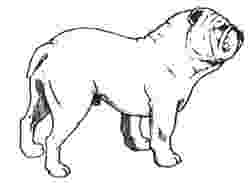
A friendly outgoing companionable breed which is readily observed in its expression and demeanor.
Disqualification — A brown or liver-colored nose.
